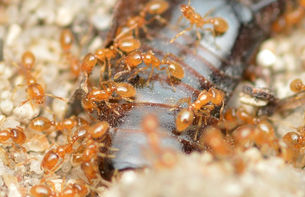A HO HO WHOLE LOTTA SAVINGS!
INSTANT $500.00 OFF YOUR FUMIGATION OR GROUND TREATMENT & WAIVE THE TAX!

PCO#1409


GIFT CARDS AVAILABLE!

TAXI ANTS, GENERAL PEST
Hawaii, with its breathtaking landscapes and exceptional biodiversity, is home to many intriguing species. Among them, taxi ants have gained attention for their ecological role and unique behaviors. Understanding taxi ants' role in Hawaii’s ecosystem is crucial for appreciating the delicate balance of native species and the pressing need for effective pest control in maintaining that balance.
Taxi ants, scientifically known as Thief Ants (Solenopsis molesta), are small, yellow-brown ants that have a fascinating habit of "hitching rides" on other ant species. This behavior allows them to gather resources and establish colonies in diverse environments.
PROUDLY SERVING ALL OF OAHU
 |  |  |  |
|---|---|---|---|
 |  |  |  |
 |  |  |  |
 |  |  |  |
 |  |  |
|---|

TAXI ANTS
WHEN IT COMES TO TAXI ANTS,
WE ABSOLUTELY STOMP THEM OUT.
Although taxi ants are not native to Hawaii, they have made their way across the islands. Their growing presence raises important questions about their ecological impact and the necessity for pest control measures. Dense populations of taxi ants can lead to significant competition with local species, creating potential challenges for Hawaii's unique ecosystems.
Taxi ants have a multifaceted role in Hawaii's ecosystems. While often viewed as pests, they do contribute to certain ecological processes. For instance, taxi ants assist in soil aeration, which promotes healthier plant growth. Additionally, their foraging behavior aids in seed dispersal, enabling native plants to spread across the landscape.
However, the introduction of non-native ant species like taxi ants can also disrupt local ecosystems. Competition for food and nesting sites can lead to declines in native ant populations. Studies indicate that invasive ants can reduce the diversity of local ant species by over 50%, adversely affecting the food web and native biodiversity. This situation highlights the need for ongoing monitoring and effective pest control strategies to protect native species.

TAXI ANTS
Implementing effective pest control strategies can help keep taxi ant populations in check, thereby protecting Hawaii's native ecosystems. Integrated Pest Management (IPM) is an effective approach to address these challenges. IPM combines biological, cultural, mechanical, and chemical methods for pest control while minimizing environmental impact.
-
Biological Control: Encouraging natural predators of taxi ants can help regulate their populations. For example, certain birds and other insects feed on ants, offering a natural means of pest control.
-
Cultural Control: Altering environmental conditions that favor taxi ants can be beneficial. Steps such as removing food sources, sealing entry points in buildings, and maintaining clean outdoor spaces can significantly deter these pests.
-
Mechanical Control: Employing physical barriers and traps can effectively capture taxi ants before they establish large colonies. Using bait stations can also help eliminate entire colonies.
-
Chemical Control: While pesticides may sometimes be necessary, they should be used judiciously. Targeted applications can reduce the risk to beneficial species and minimize environmental impact. These integrated strategies not only help control taxi ant populations but also prevent other invasive species from becoming established in Hawaii's delicate ecosystems.
TOUGHER THAN TERMITES
DON'T WAIT, TILL IT'S TOO LATE
Delaying treatment can escalate costs dramatically. In extreme cases, homes can suffer so much damage that they become unsafe. Additionally, homes with histories of termite issues experience drops in resale value. Potential buyers may be reluctant to invest in a property marked by pest damage, which can further complicate your financial situation.













